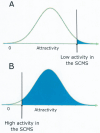Sex Differences in Sexual Motivation in Humans and Other Mammals: The Role of Conscious and Unconscious Processes
- PMID: 38667073
- PMCID: PMC11047354
- DOI: 10.3390/bs14040277
Sex Differences in Sexual Motivation in Humans and Other Mammals: The Role of Conscious and Unconscious Processes
Abstract
In self-report questionnaires, men report higher scores than women on variables such as desire for sex, frequency of sexual thoughts, number of sex partners, etc. Based on this, men are considered to have a higher level of sexual motivation than women. However, retrospective self-reports may be unsuitable for estimations of the inherent level of sexual motivation. We review data on automatic (unconsciously controlled) responses and measures of implicit motivation during exposure to sexual stimuli. These responses and measures are inaccessible to willful manipulations and make it possible to determine whether the sex difference in answers to questionnaires is replicated when volitional response manipulations are unlikely. We complement the human data with observations from some rodent and non-human primate species. The attentional resources allotted to stimuli with sexual relevance as well as genital responses to such stimuli are similar in men and women. Measures of implicit motivation also fail to detect any sex difference. Finally, the frequency of masturbation is superior in female infants before the age at which social expectations begin to determine behavior. Neither in rodents nor in non-human primates is there any clear-cut evidence for sex differences in motivation. It seems that males and females are similar with regard to the intensity of sexual motivation. The responses to questionnaires may be affected by social learning of sexual scripts and/or the inferior quality of sexual experiences in women, among other things.
Keywords: automatic (unconscious) responses; genital response; human; implicit motivation; primate; rodent; sexual scripts; volitional responses.
Conflict of interest statement
The authors declare no conflicts of interest.
Figures




Similar articles
-
Sexual Motivation (Desire): Problems with Current Preclinical and Clinical Evaluations of Treatment Effects and a Solution.Behav Sci (Basel). 2025 May 9;15(5):642. doi: 10.3390/bs15050642. Behav Sci (Basel). 2025. PMID: 40426419 Free PMC article. Review.
-
Implicit Measures in Clinical Sex Research: A Critical Evaluation.Sex Med Rev. 2020 Oct;8(4):531-541. doi: 10.1016/j.sxmr.2020.06.005. Epub 2020 Aug 5. Sex Med Rev. 2020. PMID: 32768359 Review.
-
Gender-specificity of solitary and dyadic sexual desire among gynephilic and androphilic women and men.J Sex Med. 2014 Apr;11(4):980-994. doi: 10.1111/jsm.12430. Epub 2014 Jan 21. J Sex Med. 2014. PMID: 24443962
-
Attentional Bias for Pain and Sex, and Automatic Appraisals of Sexual Penetration: Differential Patterns in Dyspareunia vs Vaginismus?J Sex Med. 2016 Aug;13(8):1255-62. doi: 10.1016/j.jsxm.2016.05.008. Epub 2016 Jun 18. J Sex Med. 2016. PMID: 27329543
-
Attentional and affective processing of sexual stimuli in women with hypoactive sexual desire disorder.Arch Sex Behav. 2012 Aug;41(4):891-905. doi: 10.1007/s10508-011-9820-7. Epub 2011 Sep 3. Arch Sex Behav. 2012. PMID: 21892693
Cited by
-
Sexual Motivation (Desire): Problems with Current Preclinical and Clinical Evaluations of Treatment Effects and a Solution.Behav Sci (Basel). 2025 May 9;15(5):642. doi: 10.3390/bs15050642. Behav Sci (Basel). 2025. PMID: 40426419 Free PMC article. Review.
-
Impact of Infertility and Medically Assisted Reproduction Treatments on Female Sexuality.JBRA Assist Reprod. 2025 Jul 30;29(2):251-257. doi: 10.5935/1518-0557.20240100. JBRA Assist Reprod. 2025. PMID: 39835798 Free PMC article.
References
-
- Lancaster R.N. The Trouble with Nature. Sex in Science and Popular Culture. University of Caifornia Press; Berkeley, CA, USA: 2003.
-
- Baumeister R.F., Catanese K.R., Vohs K.D. Is there a gender difference in strength of sexual drive? Theoretical views, conceptual distinctions, and a review of relevant evidence. Pers. Soc. Psychol. Rev. 2001;5:242–273. doi: 10.1207/S15327957PSPR0503_5. - DOI
Publication types
LinkOut - more resources
Full Text Sources

